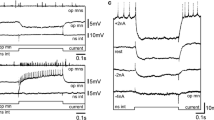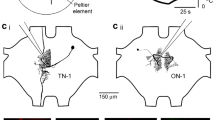Summary
-
1.
Neuronal mechanism of the directional sensitivity in the crayfish statocyst interneurons was investigated by partial ablation of the crescent-like arrangement of statocyst receptors on the statocyst floor.
-
2.
Interneuron C1 which responded to head-up tilting in the pitch plane received input from the contralateral statocyst. Ablation of those receptors located in the most anterior region of the sensory crescent significantly decreased the C1 response.
-
3.
Interneuron C2 which responded to head-up and -down tilting in the pitch plane received input from the contralateral statocyst. Ablation of those receptors located in the anterior half of the crescent completely abolished the C2 response to head-up tilting but the response to head-down tilting was affected insignificantly. Subsequent ablation of the remaining receptors obliterated the response to head-down tilting.
-
4.
Since anterior, lateral and posterior receptors are excited only by head-up, statocyst-side-up and head-down tilting respectively, we conclude that the directional sensitivity of the statocyst interneuron is based on its selective connection with a particular group of receptors which are located in a specific region of the sensory crescent.
-
5.
Functional connections of other two statocyst interneurons (I1 and I2) with statocyst receptors are deduced from their response directionality and input statocyst.
Similar content being viewed by others
References
Calabrese RL (1976) Crayfish mechanoreceptive interneurons. I. The nature of ipsilateral excitatory inputs. J Comp Physiol 105:83–102
Edwards JS, Palka J (1974) The cerci and abdominal giant fibres of the house cricket,Acheta domesticus. I. Anatomy and physiology of normal adults. Proc R Soc Lond [Biol] 185:83–103
Fraser PJ (1974) Interneurones in crab connectives (Carcinus maenas (L.)): Directional statocyst fibres. J Exp Biol 61:615–628
Fraser PJ (1977) Directionality of a one way movement detector in the crayfishCherax destructor. J Comp Physiol 118:187–193
Heitier WJ, Pearson KG (1980) Non-spiking interactions and local interneurones in the central pattern generator of the crayfish swimmeret system. Brain Res 187:206–211
Kouyama N, Shimozawa T, Hisada M (1981) Transducing element of crustacean mechano-sensory hairs. Experientia 37:379–380
Letourneau JG (1976) Somatotopic organization of afferent axons in peripheral nerves. J Comp Physiol 110:25–32
Mellon DeF (1963) Electrical responses from dually innervated tactile receptors on the thorax of the crayfish. J Exp Biol 40:137–148
Ozeki M, Takahata M, Hisada M (1978) Afferent response patterns of the crayfish statocyst with ferrite grain statolith to magnetic field stimulation. J Comp Physiol 123:1–10
Palka J, Olberg R (1977) The cercus to giant interneuron system of crickets. III. Receptive field organization. J Comp Physiol 119:301–317
Sandeman DC, Kien J, Erber J (1975) Optokinetic eye movements in the crab,Carcinus maenas II. Responses of optokinetic interneurons. J Comp Physiol 101:259–274
Schöne H, Steinbrecht RA (1968) Fine structure of the statocyst receptor ofAstacus fluviatilis. Nature 220:184–186
Suga N, Katsuki Y (1961) Central mechanism of hearing in insects. J Exp Biol 38:545–558
Takahata M (1981) Functional differentiation of crayfish statocyst receptors in sensory adaptation. Comp Biochem Physiol [A] 68:17–23
Takahata M, Hisada M (1979) Functional polarization of statocyst receptors in the crayfishProcambarus clarkii Girard. J Comp Physiol 130:201–207
Takahata M, Hisada M (1982) Statocyst interneurons in the crayfishProcambarus clarkii Girard. I. Identification and response characteristics. J Comp Physiol 149:287–300
Takahata M, Nagayama T, Hisada M (1981) Physiological and morphological characterization of anaxonic non-spiking interneurons in the crayfish motor control system. Brain Res 226:309–314
Walthall WW, Hartman HB (1981) Receptors and giant inter neurons signaling gravity orientation information in the cockroachArenivaga. J Comp Physiol 142:359–369
Westin J, Langberg JJ, Camhi JM (1977) Responses of giant interneurons of cockroachPeriplaneta americana to wind puffs of different directions and velocities. J Comp Physiol 121:307–324
Wiese K (1976) Mechanoreceptors for near-field water displacements in crayfish. J Neurophysiol 39:816–833
Wiese K, Calabrese RL, Kennedy D (1976) Integration of directional mechanosensory input by crayfish interneurons. J Neurophysiol 39:834–843
Author information
Authors and Affiliations
Rights and permissions
About this article
Cite this article
Takahata, M., Hisada, M. Statocyst interneurons in the crayfishProcambarus clarkii girard. J. Comp. Physiol. 149, 301–306 (1982). https://doi.org/10.1007/BF00619144
Accepted:
Issue Date:
DOI: https://doi.org/10.1007/BF00619144




